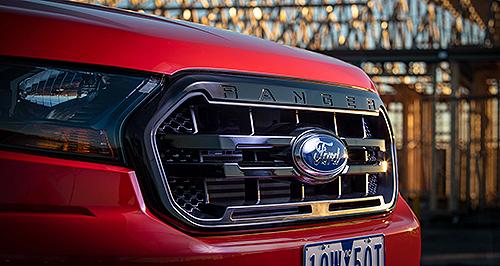Make / Model Search
News - General News - EmissionsCar industry emissions remain high in AustraliaChoices: The Toyota HiLux and Ford Ranger were number one and two respectively for sales across the total market last year, but the ‘greenest choice’ among utes was the diesel-powered Nissan Navara. CO2 levels across auto sector stuck in traffic with 0.2 per cent reduction last year24 Jun 2020 By TERRY MARTIN AUSTRALIA’S move toward electrified vehicles has failed to make any significant impact on the average carbon dioxide emissions from new light vehicles sold across the nation, with the latest figures from the National Transport Commission (NTC) released this week showing a meagre 0.2 per cent improvement was achieved last year.
Covering all new passenger cars, SUVs and light-commercial vehicles in the marketplace, the national CO2 emissions intensity performance of 180.5 grams per kilometre is the lowest rate of reduction recorded since data collection started in 2002.
It follows an underwhelming 0.4 per cent improvement in 2018 (to 180.9g/km), and a 0.3 per cent reduction in 2017 (to 181.7g/km), and again reinforces the painfully slow rate of change in Australia – now at less than two per cent annually for five years in a row, and marking only a 3.7g/km decline in total from 2015 to 2019.
The stagnation reflects Australian consumers’ long-held preference for larger vehicles – particularly SUVs and utes in today’s market – and automatic transmissions, as well as the absence of mandatory CO2 targets and other initiatives that successive governments have either avoided or had defeated before hitting the statute books.
The irony is that the Australian car industry has long been prepared to accept mandatory CO2 targets and other regulatory reforms such as the federal carbon emissions trading scheme proposed more than a decade ago.
As it does every year, the NTC has emphasised that if consumers who purchased a new vehicle last year chose the one with best-in-class emissions, the results would be vastly different – in last year’s case, the CO2 average would have plummeted 63 per cent to just 67g/km.
The trouble is, ‘green’ vehicles – defined in this case as emitting no more than 120g/km – made up only 5.7 per cent of total light vehicle sales in 2019 (57,782 units), up 4.1 per cent on the previous year but making no serious dent in the overall result.
Full-electric and plug-in hybrid electric vehicle sales totalled 5875 units in 2019, a rise of 149.1 per cent on the 2357 EVs sold the previous year but no more than a fraction (0.57 per cent by our calculations using FCAI and NTC data) of the 1,027,848 officially registered light vehicles across the entire market.
The NTC’s latest report shows that despite regular powertrain updates across the market, CO2 emissions intensity for light-commercial vehicles actually increased last year by 0.7 per cent, with the ever-popular 4x4 pick-ups/cab-chassis the worst offenders with an increase of 0.9 per cent to 226g/km.
The SUV category overall dropped 1.1 per cent to 179g/km, although small SUVs stood out as the only segment not to record an improvement – up 0.5 per cent to 157g/km.
Among other key results, the average emissions intensity from government fleets fell 2.0 per cent last year to 191g/km – still a high level of intensity owing to the large numbers of LCVs purchased, but reflecting policies to purchase electrified vehicles where possible – while the CO2 average for business fleet purchases rose 0.2 per cent to 186g/km.
Private buyers were in greener pastures, down 0.4 per cent for the year to 174g/km.
There were no surprises among the individual car manufacturers, with the top-selling brands generally returning high levels of CO2 emissions given broad line-ups and an emphasis on the biggest-selling segments – SUVs and pick-ups.
Ford, which does not at this stage have electrified vehicles in its range and relies heavily on its Ranger ute for its sales volume, had the highest average emissions intensity among the top 15 best-selling brands at 210g/km – ahead of Holden, Isuzu Ute, Mitsubishi, Toyota and Nissan, all of which were above the industry average – while Suzuki, which specialises in small cars and is also still without an EV or hybrid in Australia, was the lowest at 128g/km.
Notably, BMW’s CO2 average increased more than any other brand last year – up 7.3 per cent to 162g/km, while arch-rival Mercedes-Benz Cars was next with a 3.5 per cent uptick to 166g/km.
Subaru (167g/km) and the hybrid-rich market-leading brand Toyota (188g/km) were the biggest improvers, cleaning up their act by 4.4 and 4.3 per cent respectively.
Ford also improved over the course of the year, dropping 2.8 per cent, while Mercedes-Benz Vans went in the wrong direction, pushing up its CO2 average by a disappointing 8.1 per cent to 198g/km.  Read more6th of January 2020  VFACTS: Car industry takes big hit in 2019Hefty 7.8 per cent new-car sales downturn reflects ‘tough year’ for Australia: FCAI30th of August 2019  Australia’s car CO2 emissions remain highMild 0.4 per cent fall in vehicle emissions in 2018 as SUV, ute love affair rolls on12th of June 2018  Australian average CO2 reduction continues to stallSUV popularity continues to slow reduction of average CO2 emissions in Australia |
Click to shareGeneral News articlesResearch General News Motor industry news |











Facebook Twitter Instagram